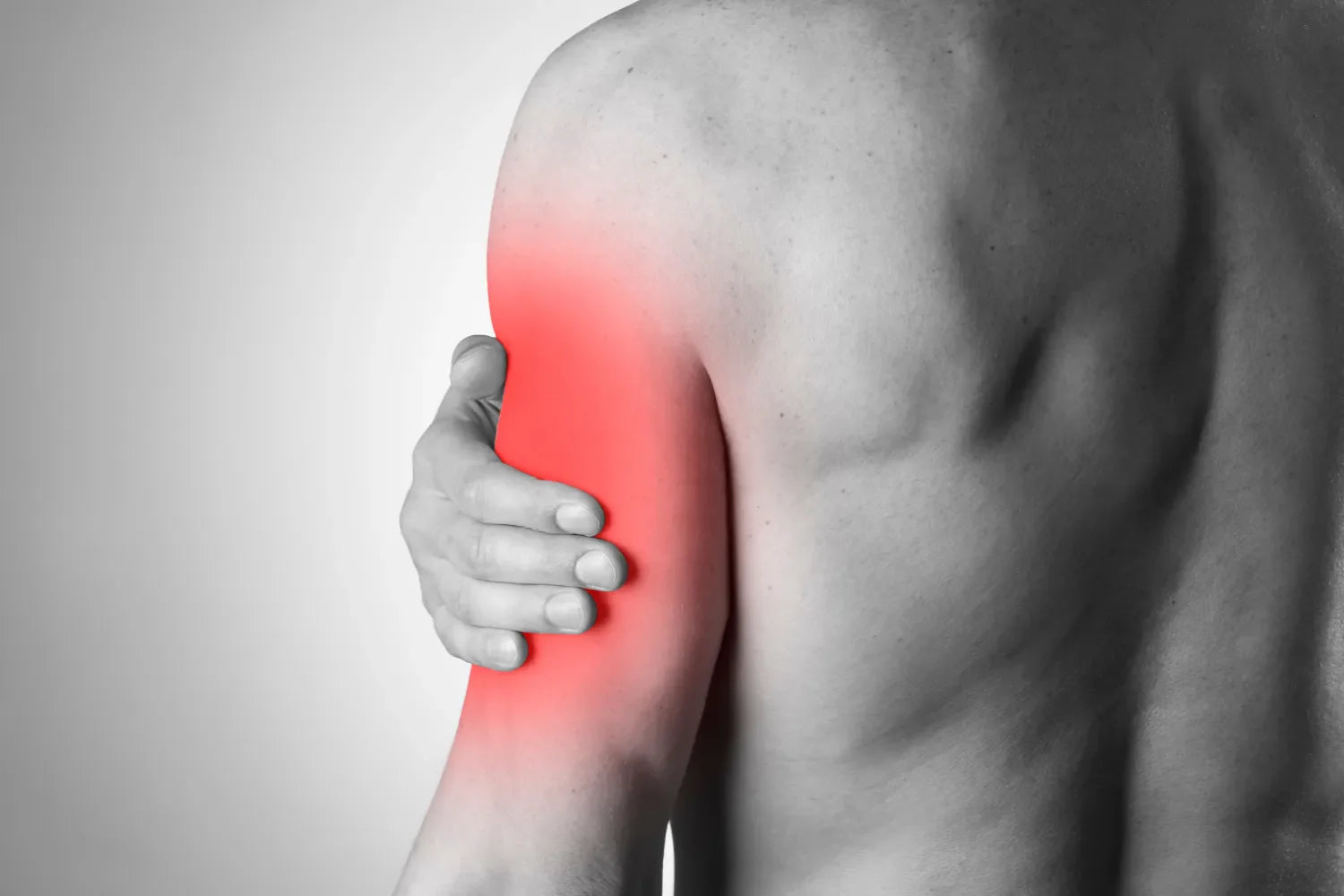
Pain in the upper left arm, between the elbow and shoulder, is a common complaint with a range of potential causes. From minor overuse injuries to serious conditions requiring immediate medical attention, understanding the source of discomfort is crucial for finding relief.
While discomfort in the left arm can often be traced back to muscular strain or joint issues, it’s important to recognize that pain in this area may sometimes signal a more serious problem, such as a heart attack.
Taking the time to learn about the structures in the arm and the conditions that can affect them will help you feel more confident about managing or addressing your symptoms.
What Can Cause Discomfort in the Upper Left Arm?
Pain in the upper left arm can stem from various possible causes, ranging from temporary muscle strain or a sprain to chronic conditions or even life-threatening emergencies.
Below are some of the most common causes to consider:
1. Musculoskeletal Issues
Many cases of arm pain are related to musculoskeletal problems, often caused by overuse, injury, or age-related wear and tear.
These include:
- Tendinitis: Inflammation of the tendons, often resulting from repetitive movements, can cause tenderness and discomfort in the upper arm.
- Rotator Cuff Injuries: Strain, tears, or impingement in the rotator cuff—the group of muscles and tendons stabilizing the shoulder—can lead to shoulder pain that radiates into the arm.
- Frozen Shoulder:This condition causes stiffness and pain in the shoulder joint, which can extend down the arm and significantly limit mobility.
- Bursitis: When the bursa becomes inflamed, the resulting pain often feels sharp or aching, especially during movement.
- Tennis Elbow: Overuse of the forearm muscles and tendons near the elbow can lead to tennis elbow that may extend into the upper arm.
- Osteoarthritis and Rheumatoid Arthritis: These forms of arthritis can affect the shoulder joint, causing chronic soreness and reduced flexibility.
2. Nerve-Related Causes
Nerve compression or irritation can also lead to pain, weakness, or tingling in the arm:
- Pinched Nerve: Compression of a nerve in the cervical spine or shoulder can cause radiating pain, numbness, or a "pins-and-needles" sensation in the arm.
- Carpal Tunnel Syndrome: Compression of the median nerve in the wrist can cause pain, tingling, or weakness that may extend up the arm.
- Thoracic Outlet Syndrome:This condition involves the compression of nerves or blood vessels in the upper chest, resulting in arm discomfort, swelling, or weakness.
- Herniated Disc:A herniated disc in the neck can press on nearby nerves, causing pain to radiate down the shoulder and arm.
3. Circulatory or Cardiovascular Conditions
While less common, pain in the upper left arm may indicate a circulatory or cardiovascular issue:
- Heart Attack or Angina: Pain in the left arm, especially when accompanied by chest pain or shortness of breath, may be a symptom of a heart attack. This type of pain often feels dull, heavy, or radiating.
- Blood Clot:Rarely, a blood clot in the arm’s blood vessels can cause localized pain, swelling, or discoloration. This requires immediate medical attention.
Understanding Common Symptoms and Warning Signs
Different causes of arm pain have unique symptoms. For instance, muscle soreness that feels like a dull ache or stiffness is often linked to overuse or minor injuries, while more severe pain, like a sharp or intense discomfort, may suggest a more serious issue like a rotator cuff tear or dislocation.
A radiating discomfort traveling from the neck or shoulder to the arm is common in nerve-related conditions like a pinched nerve or herniated disc. Numbness or tingling may be associated with nerve compression or circulation issues.
Another possible symptom is muscle weakness. Reduced strength or inability to perform usual activities can signal an underlying problem requiring medical attention.
If your arm pain is accompanied by symptoms such as chest pain, shortness of breath, nausea, jaw pain, discomfort in the upper back and shoulder blade, or sudden weakness, these could be signs of a heart attack and warrant immediate emergency care.
By exploring the causes and symptoms of upper left arm pain, you can better understand how to address your discomfort and determine when professional care may be necessary.
How Is Upper Left Arm Pain Diagnosed?
Diagnosing the cause of pain in the upper left arm involves a combination of physical examination, medical history, and diagnostic tools.
A healthcare professional may begin by assessing symptoms such as muscle weakness, soreness, or swelling and examining the arm’s range of motion. They’ll ask questions about your activities, any recent injuries, and when the discomfort started.
Imaging tests like X-rays are often used to detect fractures, dislocations, or joint degeneration. For nerve-related conditions such as a pinched nerve or thoracic outlet syndrome, advanced imaging like an MRI or CT scan may be required.
Blood flow studies can help rule out blood clots or circulation issues. Early diagnosis is key to finding an effective treatment plan and preventing the condition from worsening.
Treatment Options for Upper Left Arm Pain
Treating arm pain depends on its cause and severity. While minor discomfort often improves with rest and self-care, more serious conditions may require professional intervention.
Once medical emergencies like a heart attack or blood clot have been ruled out, many causes of upper arm pain can be tended to with the following methods.
Rest and Activity Modification
Reducing repetitive motions or overuse can give strained muscles and joints time to heal. Taking breaks from high-impact activities and limiting daily activities that cause strain like repetitive reaching our heavy lifting can help with the recovery process.
Ice and Heat Therapy
Ice packs can soothe recent injuries or swelling, while heat therapy helps ease chronic tension or stiffness in the muscles and joints. You can use ice to help provide immediate relief after a sprain or sports injury and switch to heat later in the recovery process. Heat may also help soothe nerve-related discomfort.
Medications
Certain over-the-counter pain medications may help manage swelling and discomfort from conditions like tendinitis or bursitis.
Compression Gear for Recovery
Wearing a compression sleeve during recovery can provide targeted support for the arm. Compression gear helps support healthy blood flow to the affected area, soothing swelling and soreness.
It also offers a sense of stability, which can be reassuring while engaging in light activities. Using compression gear as part of your recovery plan can support a quick return to daily routines by providing gentle pressure to help soothe discomfort and reduce stiffness.
Physical Therapy and Medical Interventions
For persistent or severe cases, physical therapy is often recommended. A therapist can guide you through exercises designed to restore strength, flexibility, and range of motion. In cases like a rotator cuff tear or severe joint damage, surgical repair may be necessary. Splints or braces can provide additional support during recovery.
Tips for Preventing Upper Left Arm Pain
Taking proactive steps to protect your arm and shoulder can help prevent future discomfort.
Here are some effective strategies:
Strengthening and Stretching
Regularly strengthening the muscles surrounding the shoulder and upper arm can reduce the risk of injury. Stretching before and after exercise is also key to maintaining flexibility and reducing tension.
Ergonomics and Posture
Good posture and proper ergonomics, especially during repetitive tasks or extended periods at a desk, can prevent strain on the neck and shoulders, reducing the likelihood of nerve compression or overuse injuries. Practicing good posture or using posture support or stabilizing back support can help encourage proper form and reduce discomfort.
Addressing Early Signs of Discomfort
If you notice soreness or stiffness in your upper arm, addressing it early can prevent it from escalating. Rest, gentle stretching, and compression gear can be helpful tools to manage minor issues before they develop into more significant problems.
The Bottom Line
Discomfort in the upper left arm can be frustrating and even alarming, but understanding its potential causes and solutions can help you take control of your health. Whether you’re dealing with muscle soreness, joint stiffness, or nerve discomfort, there are effective steps you can take to feel better and stay active.
At Copper Fit, we know how important it is to stay comfortable and mobile. That’s why we’re committed to offering high-quality compression gear designed to support your recovery, enhance performance, and help you move with confidence.
Our goal is to keep you feeling strong and ready to take on whatever challenges come your way.
Sources:
Pinched nerve - Symptoms and causes | Mayo Clinic
Beyond Chest Pain: Key Facts on Heart Attacks | Stony Brook Heart Institute
Ice Packs vs. Warm Compresses For Pain | Johns Hopkins Medicine





